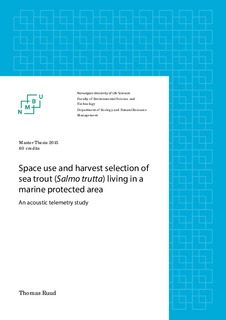| dc.description.abstract | The sea trout (Salmo trutta) is popular anadromous fish that has long traditions as game for recreational and sports fishing. However, the habitat utilization of the sea trout in a fjord system is poorly studied. It may be influenced by internal factors like size, sex and early life-history in freshwater, as well as external agents like season and weather conditions. As valuable target species for anglers, the sea trout is subject to unknown harvest pressure in the marine environment. Individuals may experience different harvest pressure according to their different behavior types and habitat use. Marine protected areas (MPA) has become a leading measure to reduce selective harvest pressure on exposed species. However, the degree of protection against anglers is dependent on species behavior types.
The objectives of this study were to find the long-term life history characteristics and habitat use of the sea trout in Tvedestrandsfjorden, compared to early life-history in freshwater and environmental agents. The results were later used to quantify the efficacy of the MPA, and how utilization of the MPA influenced the final fates of the sea trout.
I used acoustic telemetry to passively monitor 56 tagged sea trout from April 2013 to September 2014 in Tvedestrandsfjorden. The data was later processed in Rstudio where habitat use metrics like utilization distribution and volume, total daily distance, turboness and mean depth utilization where estimated. The spatiotemporal data was coupled with the use of the MPA along with the final fates of the tagged specimens, to see the efficacy of the reserve.
The results revealed that length at tagging, probability of using the no-take zone and especially smolt length highly influenced the behavior and final fates of the tagged individuals. Large individuals with large smolt length, and small individuals with small smolt length, were highly exposed to fishing mortality. Intermediate individuals with middle smolt length had high survivability. The sea trout in Tvedestrandsfjorden is thus vulnerable to size-selective harvest, whereas the MPA has a limited size-selective protection efficacy and the survivability in the fjord is merely 14 %. | nb_NO |
